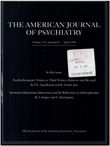Eye movement impairment and schizotypal psychopathology
Abstract
OBJECTIVE: Eye movement dysfunction in relation to a smooth pursuit task has been documented in schizophrenic patients and in patients with the related personality disorder, schizotypal personality disorder. To investigate which quantitative measures are associated with the eye movement dysfunction and whether the dysfunction is more related to the psychotic-like or the deficit-like symptoms of schizotypal personality disorder, ratings of eye movements in several groups of subjects were compared. METHOD: The study groups consisted of 26 patients with schizotypal personality disorder, 42 patients with other personality disorders (22 who also had two or more schizotypal personality traits and 20 who had fewer than two), and 37 normal comparison subjects. Smooth pursuit eye tracking of sinusoidal and constant velocity targets was recorded by an infrared eye tracking system. Two raters evaluated pursuit gain and large and small saccades in the direction of the target and in the direction opposite to that of the target (quantitative ratings) and constant velocity (qualitative rating). RESULTS: Patients with schizotypal personality disorder and patients with other personality disorders and two or more schizotypal traits, but not those with fewer than two schizotypal traits, had significantly poorer qualitative ratings of tracking than the normal comparison subjects. Neither gain nor any of the saccadic measures significantly differed between groups. The number of large saccades in the direction of the target was the only quantitative variable that predicted low qualitative ratings. Qualitatively poor tracking was associated with the deficit-like, but not the psychotic-like, symptoms of schizotypal personality disorder. CONCLUSIONS: Patients with schizotypal personality disorder demonstrate qualitatively poorer tracking than comparison groups, and the impaired tracking is associated with deficit- like symptoms.
Access content
To read the fulltext, please use one of the options below to sign in or purchase access.- Personal login
- Institutional Login
- Sign in via OpenAthens
- Register for access
-
Please login/register if you wish to pair your device and check access availability.
Not a subscriber?
PsychiatryOnline subscription options offer access to the DSM-5 library, books, journals, CME, and patient resources. This all-in-one virtual library provides psychiatrists and mental health professionals with key resources for diagnosis, treatment, research, and professional development.
Need more help? PsychiatryOnline Customer Service may be reached by emailing [email protected] or by calling 800-368-5777 (in the U.S.) or 703-907-7322 (outside the U.S.).



